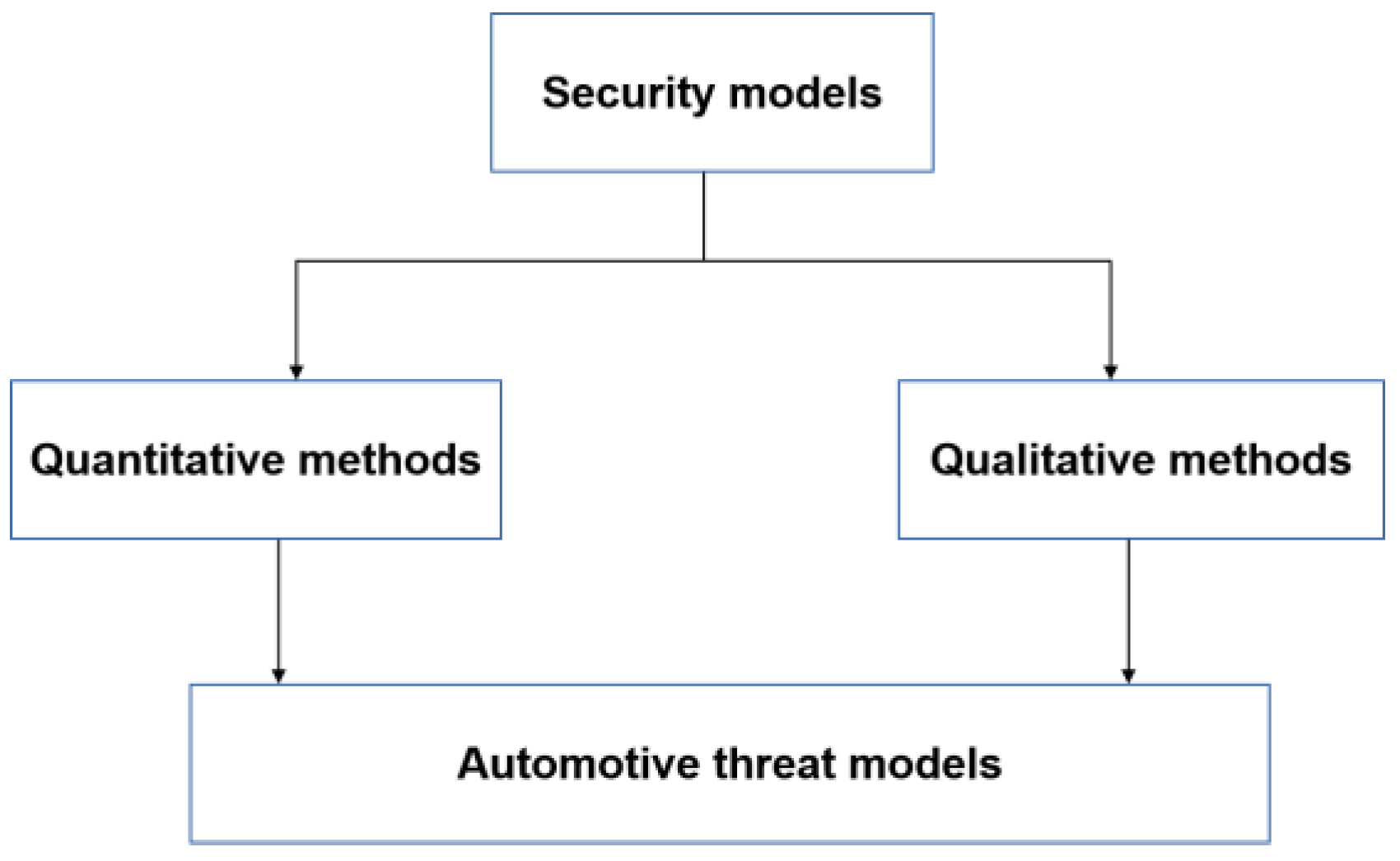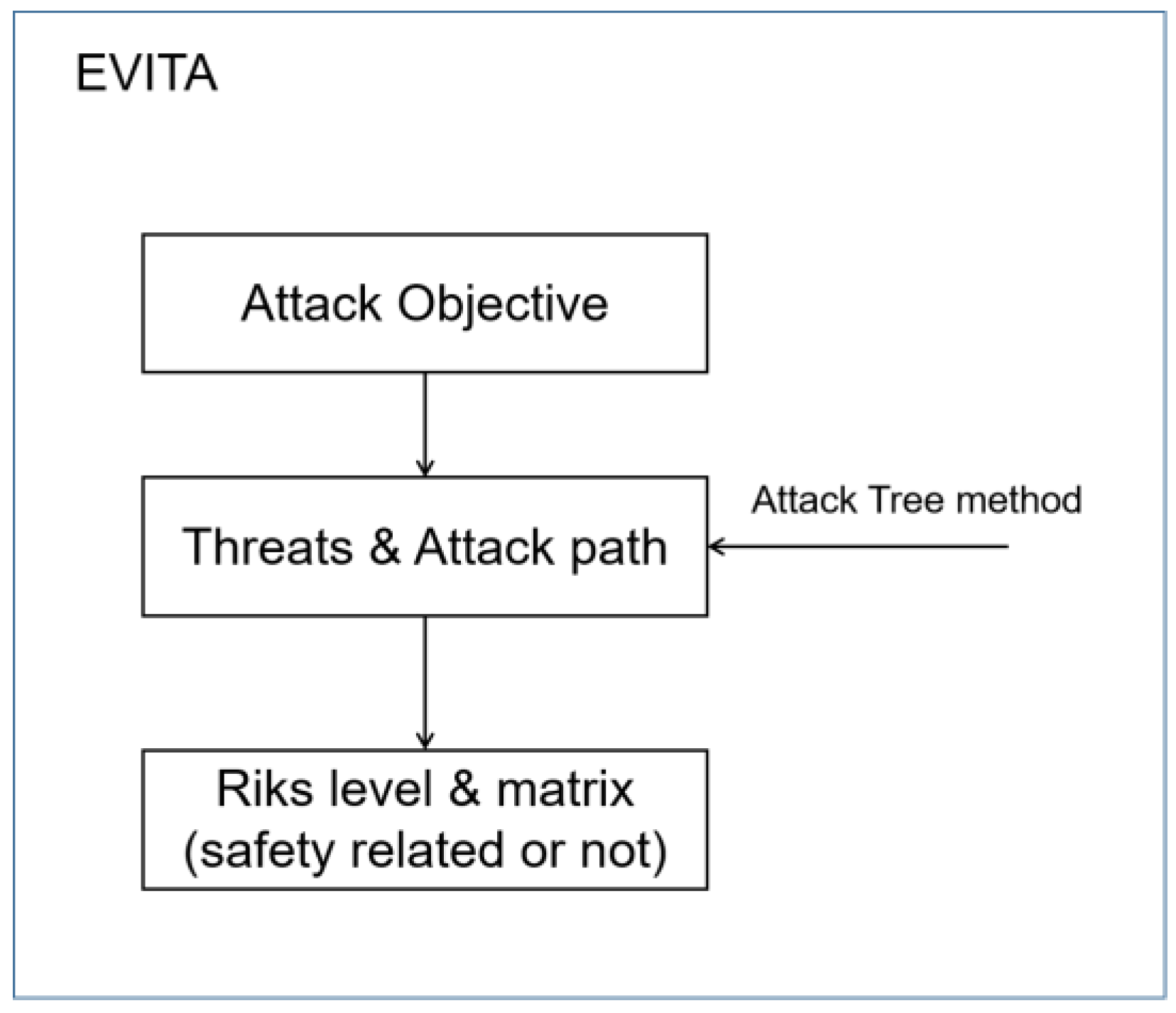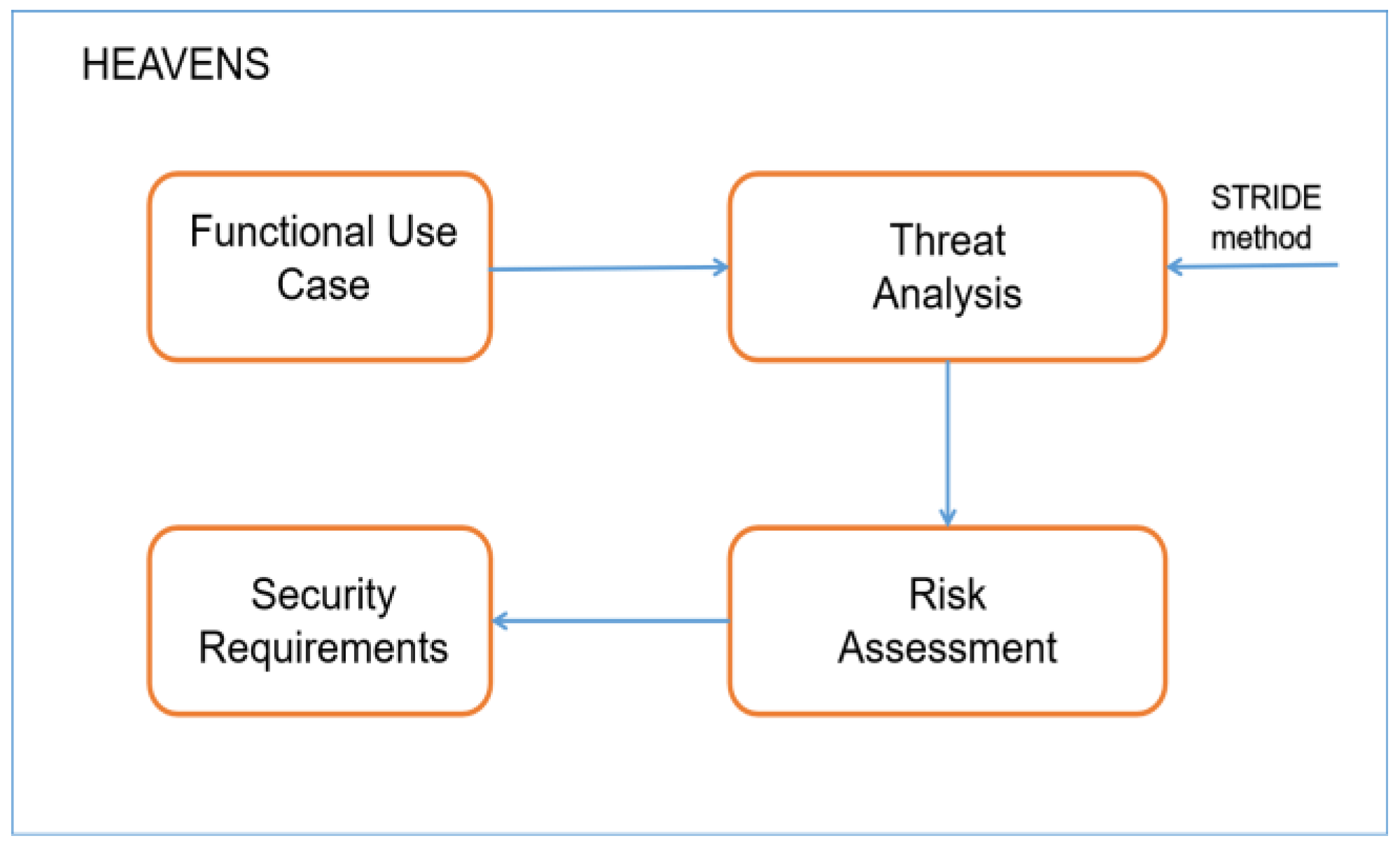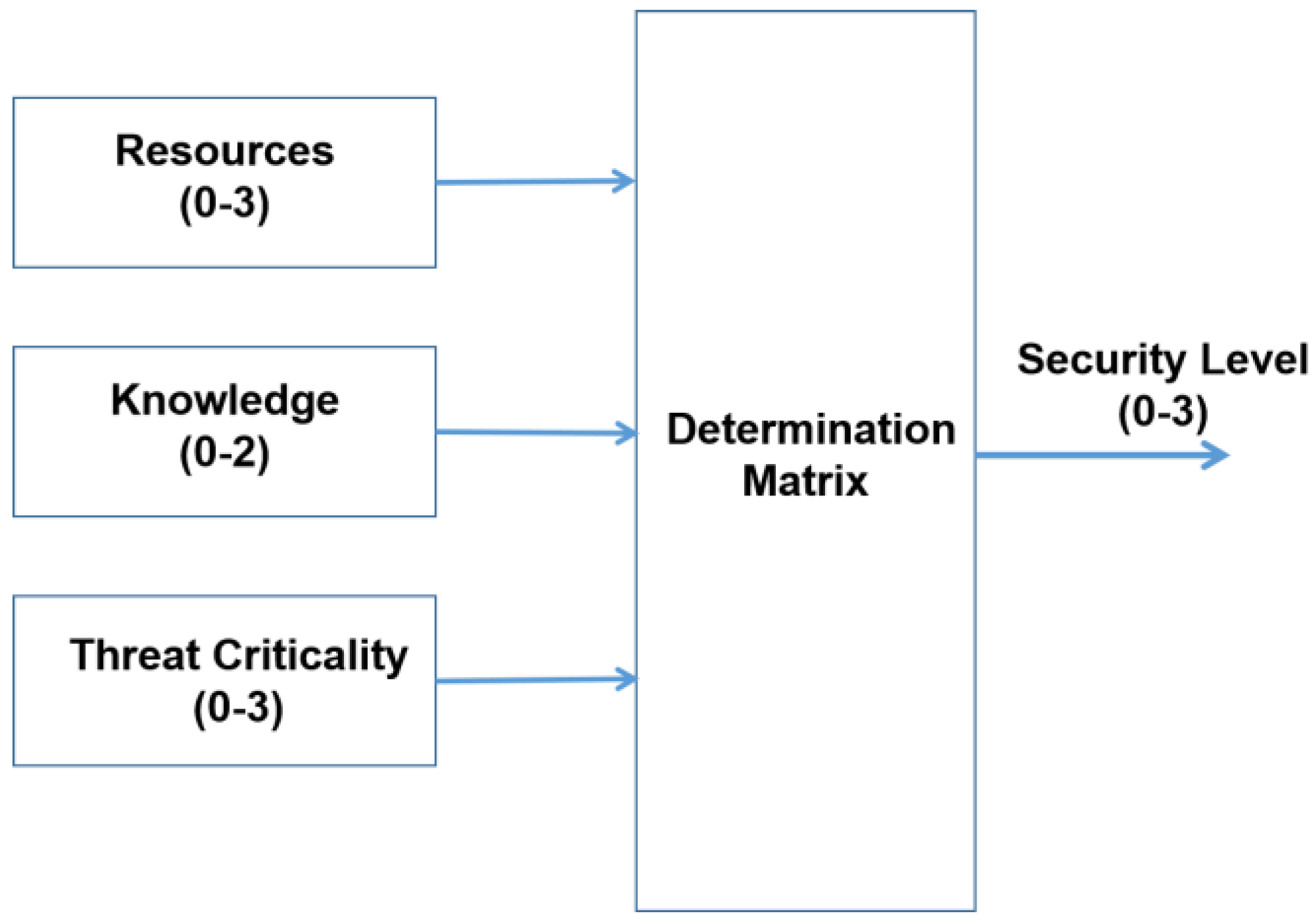On the Modeling of Automotive Security: A Survey of Methods and Perspectives
Abstract
1. Introduction
- Classifies the methods for security models into quantitative and qualitative categorizes.
- Identifies the existing framework and methods to build security models for automobiles and provides a comprehensive overview of them.
- Compares the available automotive security models for the design phase of automotive products, which are originally planned from security perspectives. The characteristics of each methodology are summarized. Based on the rational assessment, it gives a reference for automotive engineers to understand the methods then to choose the appropriate ones to initiate security evaluations.
2. Taxonomy of Security Models
2.1. Qualitative Security Methods
2.2. Quantitative Security Methods
3. Automotive Security Models
3.1. Security Modeling Methods for Automotive Industry
3.1.1. EVITA
3.1.2. HEAVENS
3.1.3. SINA
3.1.4. SAHARA
3.1.5. TVRA
3.2. Comparisons of the Automotive Security Modeling Methods
- Application context: The five modeling methods for automotive security reviewed in the last section are exploited for different usage scope. Some methods targeted on the systems on the vehicle and others took the V2X scenarios into account. For example, the method of the TVRA is designed to evaluate the communications and services of network infrastructure in the ITS.
- Security attributes: The security attributes are the protected targets of the valuable asset. Ordinarily, security is composed of the attributes of confidentiality, integrity and availability. The attributes and security objectives in the context of the automotive systems are extended by adding authenticity, accountability, authorization, privacy, non-repudiation, and freshness. The explanation of the attributes can be referred to in [83,92]. Each method specifies different security attributes as objectives.
- Reference methods: Since automotive security is developed based on the traditional IT security modeling methods, the approaches to build a threat model used either the quantitative or the qualitative methods. Most of the methods have been reviewed in Section 2.
- Safety related: The safety has always been regarded as a critical engineering concern for the automotive industry. Unlike IT security, the safety process is essential for automotive design.
- Risk impacts: Risk assessment is employed to rank the threat with impact level parameters. It aids to analyze the potential impacts of threats on the stakeholders like user, dealer or manufacturer of the vehicles. The impact factors can be considered such as the safety of the car occupants and road users, the direct and indirect financial cost for the stakeholders, the operational incidents, and the violation of privacy and regulations. These factors assist to derive the security objectives.
- Inputs and outputs: These factors can be used to better understand the models especially from the engineering point of view. The perspectives of analysis are different from the methods, and thus, the required and start point are different. Since the objectives of each method are various, the outcomes are diverse accordingly.
4. Discussion
5. Conclusions and Outlook
Author Contributions
Funding
Conflicts of Interest
References
- Li, K.; Dai, Y.; Li, S.; Bian, M. State-of-the-art and technical trends of intelligent and connected vehicles. Automot. Saf. Energy 2017, 8, 1–14. [Google Scholar] [CrossRef]
- Pelkmans, L.; Hultén, S.; Cowan, R.; Azkarate, G.; Christidis, A. Trends in Vehicle and Fuel Technologies: Review of Past Trends; European Science and Technology Observatory: Seville, Spain, 2003. [Google Scholar]
- Greenback, A. The Jeep Hackers Are Back to Prove Car Hacking Can Get much Worse. Available online: https://www.wired.com/2016/08/jeep-hackers-return-high-speed-steering-acceleration-hacks/ (accessed on 8 January 2016).
- Anderson, R. Electronic safety and security-new challenges for the car industry. In Proceedings of the 1st Workshop on Embedded Security in Cars (ESCAR), Bochum, Germany, 18–19 November 2003. [Google Scholar]
- Miller, C.; Valasek, C. A Survey of Remote Automotive Attack Surfaces. Available online: https://ioactive.com/wp-content/uploads/2018/05/IOActive_Remote_Attack_Surfaces.pdf (accessed on 1 July 2014).
- Miller, C.; Valasek, C. Remote Exploitation of an Unaltered Passenger Vehicle. Available online: https://ioactive.com/pdfs/IOActive_Remote_Car_Hacking.pdf (accessed on 10 August 2015).
- Koscher, K.; Czeskis, A.; Roesner, F.; Patel, S.; Kohno, T.; Checkoway, S.; McCoy, D.; Kantor, B.; Anderson, D.; Shacham, H.; et al. Experimental security analysis of a modern automobile. In Proceedings of the IEEE Symposium on Security and Privacy, Berkeley, CA, USA, 16–19 May 2010; pp. 447–462. [Google Scholar] [CrossRef]
- Checkoway, S.; McCoy, D.; Kantor, B.; Anderson, D.; Shacham, H.; Savage, S.; Koscher, K.; Czeskis, A.; Roesner, F.; Kohno, T. Comprehensive experimental analyses of automotive attack surfaces. In Proceedings of the 20th USENIX Conference on Security, San Francisco, CA, USA, 8–12 August 2011. [Google Scholar]
- King, J.D. Passive Remote Keyless Entry System. U.S. Patent US623,633,3B1, 22 May 2001. [Google Scholar]
- Francillon, A.; Danev, B.; Capkun, S. Relay attacks on passive keyless entry and start systems in modern cars. In Proceedings of the Network and Distributed System Security Symposium (NDSS), San Diego, CA, USA, 6–9 February 2011. [Google Scholar] [CrossRef]
- Verdult, R.; Garcia, F.D.; Balasch, J. Gone in 360 seconds: Hijacking with Hitag2. In Proceedings of the 21st 5USENIX6 Security Symposium (5USENIX6 Security 12), Bellevue, WA, USA, 8–10 August 2012; pp. 237–252. [Google Scholar]
- Verdult, R.; Garcia, F.D.; Ege, B. Dismantling Megamos Crypto: Wirelessly Lockpicking a Vehicle Immobilizer. In Proceedings of the USENIX Security Symposium, Washington, DC, USA, 14–16 August 2013; pp. 703–718. [Google Scholar]
- Eisenbarth, T.; Kasper, T.; Moradi, A.; Paar, C.; Salmasizadeh, M.; Shalmani, M.T.M. On the Power of Power Analysis in the Real World: A Complete Break of the KeeLoq Code Hopping Scheme. In Advances in Cryptology-CRYPTO 2008; Wagner, D., Ed.; Springer: Berlin/Heidelberg, Germany, 2008; Volume 5157, pp. 203–220. [Google Scholar] [CrossRef]
- Courtois, N.T.; Bard, G.V.; Wagner, D. Algebraic and Slide Attacks on KeeLoq. In Fast Software Encryption; Nyberg, K., Ed.; Springer: Berlin/Heidelberg, Germany, 2008; Volume 5086, pp. 97–115. [Google Scholar] [CrossRef]
- Hoppe, T.; Kiltz, S.; Dittmann, J. Security Threats to Automotive CAN Networks-Practical Examples and Selected Short-Term Countermeasures. In Computer Safety, Reliability, and Security; Harrison, M.D., Sujan, M.A., Eds.; Springer: Berlin/Heidelberg, Germany; New York, NY, USA, 2008; Volume 5219, pp. 235–248. [Google Scholar] [CrossRef]
- Woo, S.; Jo, H.J.; Lee, D.H. A Practical Wireless Attack on the Connected Car and Security Protocol for In-Vehicle CAN. IEEE Trans. Intell. Transp. Syst. 2014, 16, 993–1006. [Google Scholar] [CrossRef]
- Foster, I.D.; Prudhomme, A.; Koscher, K.; Savage, S. Fast and Vulnerable: A Story of Telematic Failures. In Proceedings of the Workshop on Offensive Technologies (WOOT), Washington, DC, USA, 10–11 August 2015. [Google Scholar]
- Mahaffey, K. Hacking a Tesla Model S: What We Found and What We Learned. Available online: https://blog.lookout.com/hacking-a-tesla (accessed on 5 August 2015).
- Spill, D.; Bittau, A. BlueSniff: Eve Meets Alice and Bluetooth. In Proceedings of the first USENIX workshop on Offensive Technologies (WOOT 07), Berkeley, CA, USA, 6–10 August 2007; pp. 1–10. [Google Scholar]
- Ground Vehicle Standard J3016_201806. Taxonomy and Definitions for Terms Related to on-Road Motor Vehicle Automated Driving Systems; SAE International: Warrendale, PA, USA, 2018. [Google Scholar]
- Sommer, F.; Durrwang, J. IEEM-HsKA/AAD: Automotive Attack Database (AAD). Available online: https://github.com/IEEM-HsKA/AAD (accessed on 16 April 2019).
- Eykholt, K.; Evtimov, I.; Fernandes, E.; Li, B.; Rahmati, A.; Xiao, C.; Prakash, A.; Kohno, T.; Song, D. Robust Physical-World Attacks on Deep Learning Models. Available online: http://arxiv.org/pdf/1707.08945v5 (accessed on 10 April 2018).
- Petit, J.; Stottelaar, B.; Feiri, M.; Kargl, F. Remote attacks on automated vehicles sensors: Experiments on camera and lidar. In Proceedings of the Black Hat Europe 2015, Amsterdam, The Netherlands, 10 November 2015. [Google Scholar]
- Sitawarin, C.; Bhagoji, A.N.; Mosenia, A.; Chiang, M.; Mittal, P. DARTS: Deceiving Autonomous Cars with Toxic Signs. Available online: http://arxiv.org/pdf/1802.06430v3 (accessed on 31 May 2018).
- Upstream Security Ltd. Smart Mobility Cyber Attacks Repository. Available online: https://www.upstream.auto/research/automotivecybersecurity/ (accessed on 13 August 2020).
- Ring, M.; Dürrwang, J.; Sommer, F.; Kriesten, R. Survey on vehicular attacks—Building a vulnerability database. In Proceedings of the 2015 IEEE International Conference on Vehicular Electronics and Safety (ICVES), Yokohama, Japan, 5–7 November 2015; pp. 208–212. [Google Scholar] [CrossRef]
- Sommer, F.; Dürrwang, J.; Kriesten, R. Survey and Classification of Automotive Security Attacks. Information 2019, 10, 148. [Google Scholar] [CrossRef]
- Myagmar, S.; Lee, A.J.; Yurcik, W. Threat modeling as a basis for security requirements. In Proceedings of the IEEE Symposium on Requirements Engineering for Information Security (SREIS), Paris, France, 29 August 2005. [Google Scholar]
- Lee, E.A. Cyber Physical Systems: Design Challenges. In Proceedings of the 11th IEEE Symposium onObject/Component/Service-Oriented Real-Time Distributed Computing (ISORC), Orlando, FL, USA, 5–7 May 2008; pp. 363–369. [Google Scholar] [CrossRef]
- Dykstra, J. Essential Cybersecurity Science—Build, Test, and Evaluate Secure Systems, 1st ed.; O’Reilly: Sebastopol, CA, USA, 2015. [Google Scholar]
- Fabian, B.; Gurses, S.; Heisel, M.; Santen, T.; Schmidt, H. A comparison of security requirements engineering methods. Requir. Eng. 2010, 15, 7–40. [Google Scholar] [CrossRef]
- Ma, Z.; Schmittner, C. Threat modeling for automotive security analysis. Adv. Sci. Technol. Lett. 2016, 139, 333–339. [Google Scholar] [CrossRef]
- Verendel, V. Quantified security is a weak hypothesis: A Critical Survey of Results and Assumptions. In Proceedings of the 2009 Workshop on New Security Paradigms Workshop, Oxford, UK, 8–11 September 2009; pp. 37–49. [Google Scholar]
- Pietre-Cambacedes, L.; Bouissou, M. Cross-fertilization between safety and security engineering. Reliab. Eng. Syst. Saf. 2013, 110, 110–126. [Google Scholar] [CrossRef]
- Ross, S.T. Computer security: A practical definition. In Unix System Security Tools; Mcgraw-Hill: New York, NY, USA, 1999; pp. 15–26. [Google Scholar]
- Tomas, O. A Structured Approach to Computer Security. Technical Report No. 122. 1992. Available online: https://research.chalmers.se/en/publication/166411 (accessed on 11 November 2020).
- Simson Garfinkel and Gene Spafford, Practical UNIX & Internet Security, 2nd ed.; O’Reilly: Sebastopol, CA, USA, 1996.
- Zalewski, J.; Drager, S.; McKeever, W.; Kornecki, A.J. Threat modeling for security assessment in cyberphysical systems. In Proceedings of the Eighth Annual Cyber Security and Information Intelligence Research Workshop (CSIIRW 13), Oak Ridge, TN, USA, 8–10 January 2013; Volume 10, pp. 1–4. [Google Scholar] [CrossRef]
- Jonsson, E. Towards an integrated conceptual model of security and dependability. In Proceedings of the 1st IEEE International Conference on Availability, Reliability and Security, Vienna, Austria, 20–22 April 2006; pp. 646–653. [Google Scholar] [CrossRef]
- Felderer, M.; Katt, B.; Kalb, P.; Jurjens, J.; Ochoa, M.; Paci, F.; Tran, L.M.S.; Tun, T.T.; Yskout, K.; Scandariato, R.; et al. Evolution of security engineering artifacts: A state of the art survey. Int. J. Secur. Softw. Eng. 2014, 5, 48–98. [Google Scholar] [CrossRef]
- Shevchenko, N.; Chick, T.A.; O’Riordan, P.; Scanlon, T.P.; Woody, C. Threat Modeling: A Summary of Available Methods; SEI Carnegie Mellon University: Pittsburgh, PA, USA, 2018. [Google Scholar] [CrossRef]
- Swiderski, F.; Snyder, W. Threat Modeling (Microsoft Professional); Microsoft Press: California, CA, USA, 2004; pp. 238–246. [Google Scholar]
- Shostack, A. Experiences threat modeling at Microsoft. In Proceedings of the Modeling Security Workshop, Lancaster, UK, 4–5 October 2008. [Google Scholar]
- Deng, M.; Wuyst, K.; Scandariato, R.; Preneel, B.; Joosen, W. A privacy threat analysis framework supporting the elicitation and fulfillment of privacy requirements. Requir. Eng. 2011, 16, 3–32. [Google Scholar] [CrossRef]
- LINDDUN. Privacy Threat Modeling. Available online: https://distrinet.cs.kuleuven.be/software/linddun/index.php (accessed on 26 March 2020).
- Wuyts, K.; Joosen, W. Linddun Privacy Threat Modeling: A Tutorial; linddun: Leuven, Belgium, 2015. [Google Scholar]
- Cooper, S.; Nickell, C.; Piotrowski, V.; Oldfield, B.; Abdallah, A.; Bishop, M.; Caelli, B.; Dark, M.; Hawthorne, E.K.; Hoffman, L.; et al. An exploration of the current state of information assurance education. ACM SIGCSE Bull. 2009, 41, 109–125. [Google Scholar] [CrossRef]
- Ponikwar, C.; Hof, H.J.; Wischhof, L. Towards a High-Level Security Model for Decision Making in Autonomous Driving. In Proceedings of the ACM Chapters Computer Science in Cars Symposium (CSCS), Munich, Germany, 6 July 2017; pp. 1–4. [Google Scholar]
- Cleland-Huang, J. How well do you know your personae non gratae? IEEE Softw. 2014, 31, 28–31. [Google Scholar] [CrossRef][Green Version]
- Mead, N.; Shull, F.; Vennuru, K.; Villadsen, O. A Hybrid Threat Modeling Method; Carnegie Mellon University: Pittsburgh, PA, USA, 2018. [Google Scholar]
- Tariq, A.M.; Brynielsson, J.; Artman, H. Framing the Attacker in Organized Cybercrime. In Proceedings of the European Intelligence and Security Informatics Conference (EISIC), Odense, Denmark, 22–24 August 2012; pp. 30–37. [Google Scholar] [CrossRef]
- Sindre, G.; Opdahl, A.L. Eliciting security requirements with misuse cases. Requir. Eng. 2005, 10, 34–44. [Google Scholar] [CrossRef]
- Zalewski, J.; Drager, S.; McKeever, W.; Kornecki, A.J. Can we measure security and how? ACM Int. Conf. Proc. Ser. 2013, 1, 1–4. [Google Scholar] [CrossRef]
- Common Vulnerability Scoring System v3.1: Specification Document. Available online: https://www.first.org/cvss/v3.1/specification-document (accessed on 5 October 2020).
- Common Vulnerability Scoring System v3.1: User Guide. Available online: https://www.first.org/cvss/v3.1/user-guide (accessed on 5 October 2020).
- Schneier, B. Attack trees: Modeling security threats. Dr. Dobbs J. 1999, 12, 9–21. [Google Scholar]
- Sheyner, O.; Haines, J.; Jha, S.; Lippmann, R.; Wing, J. Automated generation and analysis of attack graphs. In Proceedings of the IEEE Symposium on Security and Privacy, Berkeley, CA, USA, 12–15 May 2002; pp. 273–284. [Google Scholar]
- Moore, A.P.; Ellison, R.J.; Linger, R.C. Attack Modeling for Information Security and Survivability (CMU/SEI-2001-TN-001); Carnegie Mellon University: Pittsburgh, PA, USA, 2001. [Google Scholar] [CrossRef]
- Jonsson, E.; Olovsson, T. A quantitative model of the security intrusion process based on attacker behavior. IEEE Trans. Softw. Eng. 1997, 23, 235–245. [Google Scholar] [CrossRef]
- Kornecki, A.; Zalewski, J.; Stevenson, W.F. Availability assessment of embedded systems with security vulnerabilities. In Proceedings of the 34th Annual IEEE software Engineering Workshop, Limerick, Ireland, 20–21 June 2011; pp. 42–47. [Google Scholar] [CrossRef]
- Madan, B.B.; Gogeva-Popstojanova, K.; Vaidyanathan, K.; Trivedi, K.S. Modeling and quantification of security attributes of software systems. In Proceedings of the International Conference on Dependable Systems and Networks, Bethesda, MD, USA, 23–26 June 2002; pp. 505–514. [Google Scholar] [CrossRef]
- Potteiger, B.; Martins, G.; Koutsoukos, X. Software and attack centric integrated threat modeling for quantitative risk assessment. In Proceedings of the Symposium and Bootcamp on the Science of Security, Pittsburgh, PA, USA, 19–21 April 2016; pp. 99–108. [Google Scholar] [CrossRef]
- PRESERVE Project. Preparing Secure V2X Communication Systems (PRESERVE). Available online: http://www.preserveproject.eu/ (accessed on 5 October 2020).
- EVITA Project. E-safety Vehicle Intrusion Protected Applications (EVITA). Available online: http://www.evitaproject.org/ (accessed on 5 October 2020).
- OVERSEE Project. Open Vehicular Secure Platform (OVERSEE). Available online: https://www.oversee-project.com/ (accessed on 5 October 2020).
- Ur-Rehman, O.; Zivic, N.; Ruland, C. An Overview of Automotive Security Standards. Available online: http://docs.mipro-proceedings.com/iss/03_iss_5618.pdf (accessed on 5 October 2020).
- SAE J3061. Cybersecurity Guidebook for Cyber-Physical Vehicle Systems; SAE International: Warrendale, PA, USA, 2016. [Google Scholar]
- ISO/TR 20078-4. Road Vehicles—Extended Vehicle (ExVe) ‘Web Services’; ISO/TC 22/SC 31 Data Communication; Technical Committee: Geneva, Switzerland, 2019. [Google Scholar]
- ISO/SAE DIS 21434. Road Vehicles—Cybersecurity Engineering; ISO/TC 22/SC 32 Electrical and Electronic Components and General System Aspects; Technical Committee: Geneva, Switzerland, 2020. [Google Scholar]
- Schmittner, C.; Ma, Z. Status of the Development of ISO/SAE 21434. In Proceedings of the 25th European Conference, EuroSPI 2018, Bilbao, Spain, 5–7 September 2018. [Google Scholar] [CrossRef]
- Burkacky, O.; Deichmann, J.; Klein, B.; Pototzky, K.; Scherf, G. Cybersecurity in Automotive, Mastering the Challenge; McKinsey & Company: New York, NY, USA, 2020. [Google Scholar]
- Schmittner, C.; Ma, Z. Towards a framework for alignment between automotive safety and security standards. In Proceedings of the 34th International Conference on Computer Safety, Reliability, and Security, Delft, The Netherlands, 23–25 September 2015; pp. 133–143. [Google Scholar] [CrossRef]
- Pekaric, I.; Sauerwein, C.; Felderer, M. Applying Security Testing Techniques to Automotive Engineering. In Proceedings of the ARES’19: 14th International Conference on Availability, Reliability and Security, Canterbury, UK, 26–29 August 2019; pp. 1–10. [Google Scholar] [CrossRef]
- Schoitsch, E.; Schmittner, C.; Ma, Z.; Gruber, T. The need for safety and cybersecurity co-engineering and standardization for highly automated automotive vehicles. In Advanced Microsystems for Automotive Applications 2015; Schulze, T., Müller, B., Meyer, G., Eds.; Springer: Berlin/Heidelberg, Germany, 2016; pp. 251–261. [Google Scholar] [CrossRef]
- Schmittner, C.; Ma, Z.; Reyes, C.; Dillinger, O.; Puschner, P. Using SAE J3061 for Automotive Security Requirement Engineering. In Proceedings of the 35th International Conference on Computer Safety, Reliability, and Security, Trondheim, Norway, 20–23 September 2016. [Google Scholar] [CrossRef]
- Macher, G.; Messnarz, R.; Armengaud, E.; Riel, A.; Brenner, E.; Kreiner, C. Integrated Safety and Security Development in the Automotive Domain. In Proceedings of the SAE International WCX™ 17: SAE World Congress Experience, Detroit, MI, USA, 4–6 April 2017. [Google Scholar] [CrossRef]
- Dürrwang, J.; Beckers, K.; Kriesten, R. A Lightweight Threat Analysis Approach Intertwining Safety and Security for the Automotive Domain. In Proceedings of the SAFECOMP 2017: 36th International Conference on Computer Safety, Reliability, and Security, Trento, Italy, 12–15 September 2017; pp. 305–319. [Google Scholar] [CrossRef]
- Schmittner, C.; Gruber, T.; Puschner, P.; Schoitsch, E. Security Application of Failure Mode and Effect Analysis (FMEA). In Proceedings of the SAFECOMP 2014: 33rd International Conference on Computer Safety, Reliability, and Security, Florence, Italy, 10–12 September 2014; Volume 8666, pp. 310–325. [Google Scholar] [CrossRef]
- Raspotnig, C.; Karpati, P.; Katta, V. A Combined Process for Elicitation and Analysis of Safety and Security Requirements. In Enterprise, Business-Process and Information System; Bider, I., Halpin, T.A., Krogstie, J., Nurcan, S., Ukor, R., Eds.; Springer: Berlin/Heidelberg, Germany, 2012; Volume 113, pp. 347–361. [Google Scholar] [CrossRef]
- Macher, G.; Armengaud, E.; Brenner, E.; Kreiner, C. A Review of Threat Analysis and Risk Assessment Methods in the Automotive Context. In Computer Safety, Reliability, and Security; Skavhaug, A., Guiochet, J., Bitsch, F., Eds.; Springer: Berlin/Heidelberg, Germany, 2016; Volume 9922, pp. 130–141. [Google Scholar] [CrossRef]
- Eichler, J.; Angermeier, D. Modular risk assessment for the development of secure automotive systems. In Proceedings of the 31st VDI/VW joint conference Automotive Security, Wolfsburg, Germany, 21–22 October 2015. [Google Scholar]
- Alberts, C.J.; Behrens, S.G.; Pethia, R.D.; Wilson, W.R. Operationally Critical Threat, Asset, and Vulnerability EvaluationSM (OCTAVESM) Framework, Version 1.0; Carnegie Mellon University: Pittsburgh, PA, USA, 1999. [Google Scholar] [CrossRef]
- European Telecommunication Standards Institute (ETSI). Intelligent Transport Systems (ITS); Security; Threat, Vulnerability and Risk Analysis (TVRA); ETSI: Sophia Antipolis Cedex, France, 2017. [Google Scholar]
- Alastair, R.; Benjamin, W.; Sajid, I.; Roudier, Y.; Michael, F.; Timo, L.; Fuchs, A.; Gurgens, S.; Henninger, O.; Roland, R.; et al. Deliverable D2.3: Security Requirements for Automotive on-Board Networks Based on Dark-Side Scenarios (EVITA, E-Safety Vehicle Intrusion Protected Applications); East Valley Institute of Technology (EVIT): Mesa, AZ, USA, 2009. [Google Scholar] [CrossRef]
- Common Methodology for Information Technology Security Evaluation (CEM v3.1). Available online: https://www.commoncriteriaportal.org/files/ccfiles/CCPART1V3.1R5.pdf (accessed on 5 October 2020).
- ISO/IEC 15408: Information Technology-Security Techniques-Evaluation Criteria for IT Security; Technical Committee: Geneva, Switzerland, 2009.
- ISO 26262, Road Vehicles—Functional Safety; Technical Committee: Geneva, Switzerland, 2018.
- Wolf, M.; Scheibel, M. A systematic approach to a quantified security risk analysis for vehicular IT systems. Automot. Saf. Secur. 2012, 210, 195–210. [Google Scholar]
- British Standard EN 501261999. Railway Applications—The Specification and Demonstration of Reliability, Availability, Maintainability, and Safety (RAMS); European Committee for Eiectrotechnical Standardization: Brussels, Belgium, 1999. [Google Scholar]
- Cheah, M.; Shaikh, S.A.; Bryans, J.; Wooderson, P. Building an automotive security assurance case using systematic security evaluations. Comput. Secur. 2018, 77, 360–379. [Google Scholar] [CrossRef]
- Olovsson, T. HEAling Vulnerabilities to ENhance Software Security and Safety (HEAVENS) Project. Available online: https://research.chalmers.se/en/project/5809 (accessed on 5 October 2020).
- Islam, M.; Sandberg, C.; Bokesand, A.; Olovsson, T.; Brober, H.; Kleberger, P.; Lautenbach, A.; Hansson, A.; Soderberg-Rivkin, A. P.Kadhirvelan, S. Deliverable D2: Security Models (Version 2.0); Vinnova/FFI (Fordonsutveckling/Vehicle Development): Göteborg, Sweden, 2016. [Google Scholar]
- Islam, M.; Lautenbach, A.; Sandberg, C.; Olovsson, T. A risk assessment framework for automotive embedded systems. In Proceedings of the 2nd ACM International Workshop on Cyber-Physical System Security, Xi’an, China, 31 May 2016; pp. 3–14. [Google Scholar]
- Federal Office for Information Security (BSI) Standard 100-4; Version 1.0; Information Security Management System (ISMS): Bonn, Germany, 2009.
- Automotive Industry Action Group (AIAG). Potential Failure Mode and Effects Analysis (FMEA), 4th ed.; AIAG: Michigan, Mi, USA, 2008. [Google Scholar]
- Federal Office for information security (BSI). Privacy Impact Assessment Guideline; BSI: Bonn, Germany, 2011. [Google Scholar]
- Schmidt, K.; Troger, P.; Kroll, H.M.; Bunger, T.; Krueger, F.; Neuhaus, C. Adapted development process for security in networked automotive systems. SAE Int. J. Passeng. Cars Electron. Electr. Syst. 2014, 7, 516–526. [Google Scholar] [CrossRef]
- Macher, G.; Sporer, H.; Berlach, R.; Armengaud, E.; Kreiner, C. SAHARA: A security-aware hazard and risk analysis method. In Proceedings of the Design, Automation Test in Europe Conference Exhibition (DATE), Grenoble, France, 9–13 March 2015; pp. 621–624. [Google Scholar] [CrossRef]
- Macher, G.; Armengaud, E.; Brenner, E.; Kreiner, C. Threat and risk assessment methodologies in the automotive domain. Procedia Comput. Sci. 2016, 83, 1288–1294. [Google Scholar] [CrossRef]
- European Telecommunication Standards Institute (ETSI). Telecommunications and Internet Converged Services and Protocols for Advanced Networking (TISPAN); Methods and Protocols, Part 1: Method and proforma for Threat, Risk, Vulnerability Analysis; ETSI: Sophia Antipolis Cedex, France, 2011. [Google Scholar]






| Factors Methods | Application Context | Security Attributes | Reference Methods | Safety-Related | Risk Impact | Inputs & Outputs |
|---|---|---|---|---|---|---|
| EVITA | Vehicular IT systems | Authenticity, Integrity, Authorization, Freshness, Non-repudiation, Privacy, Confidentiality, Availability | Attack tree | YES | Safety, Finance, Privacy, Operation | Input: system use cases and assets Output: attack scenarios, risk levels and security requirements |
| HEAVENS | Automotive electrical and/or electronic systems | Confidentiality, Availability, Integrity, Authenticity, Authorization, Non-repudiation, Privacy, Freshness | STRIDE | YES | Safety, Finance, Privacy & legislation, Operation | Input: functional use cases Output: risk matrix with threat level and impact level, high-level security requirements |
| SINA | Connected vehicle systems | Authenticity, Availability, Integrity, Confidentiality, Authorization | STRIDE (with different threat types), Attack tree | YES | Safety | Input: system use cases Output: the list of threats, failure mode, potential effects and severity |
| SAHARA | Automotive embedded systems | Confidentiality, Availability, Integrity | STRIDE | YES | Safety | Input: the outcomes of safety analysis Output: threat level and security level |
| TVRA | Communications and services in ITS | confidentiality, integrity, availability, authenticity, accountability | TVRA for Telecommunications | NO | Availability of the network, Customer confidence | Input: ITS target of evaluation Output: risk determination and possible countermeasures |
Publisher’s Note: MDPI stays neutral with regard to jurisdictional claims in published maps and institutional affiliations. |
© 2020 by the authors. Licensee MDPI, Basel, Switzerland. This article is an open access article distributed under the terms and conditions of the Creative Commons Attribution (CC BY) license (http://creativecommons.org/licenses/by/4.0/).
Share and Cite
Hao, J.; Han, G. On the Modeling of Automotive Security: A Survey of Methods and Perspectives. Future Internet 2020, 12, 198. https://doi.org/10.3390/fi12110198
Hao J, Han G. On the Modeling of Automotive Security: A Survey of Methods and Perspectives. Future Internet. 2020; 12(11):198. https://doi.org/10.3390/fi12110198
Chicago/Turabian StyleHao, Jingjing, and Guangsheng Han. 2020. "On the Modeling of Automotive Security: A Survey of Methods and Perspectives" Future Internet 12, no. 11: 198. https://doi.org/10.3390/fi12110198
APA StyleHao, J., & Han, G. (2020). On the Modeling of Automotive Security: A Survey of Methods and Perspectives. Future Internet, 12(11), 198. https://doi.org/10.3390/fi12110198





